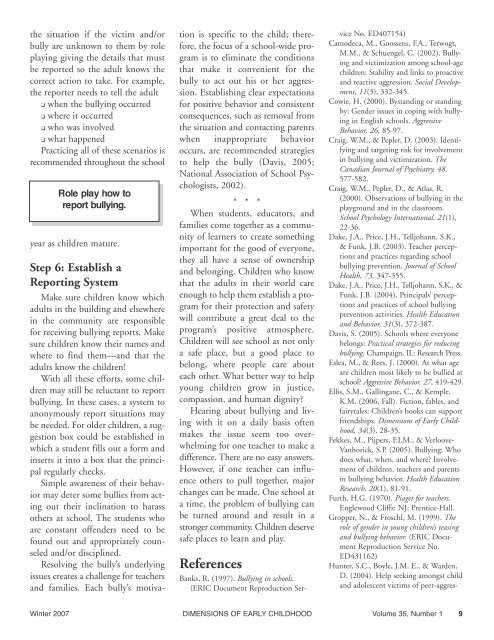Dimensions of Early Childhood - Southern Early Childhood ...
Dimensions of Early Childhood - Southern Early Childhood ...
Dimensions of Early Childhood - Southern Early Childhood ...
Create successful ePaper yourself
Turn your PDF publications into a flip-book with our unique Google optimized e-Paper software.
the situation if the victim and/or<br />
bully are unknown to them by role<br />
playing giving the details that must<br />
be reported so the adult knows the<br />
correct action to take. For example,<br />
the reporter needs to tell the adult<br />
❑ when the bullying occurred<br />
❑ where it occurred<br />
❑ who was involved<br />
❑ what happened<br />
Practicing all <strong>of</strong> these scenarios is<br />
recommended throughout the school<br />
Role play how to<br />
report bullying.<br />
year as children mature.<br />
Step 6: Establish a<br />
Reporting System<br />
Make sure children know which<br />
adults in the building and elsewhere<br />
in the community are responsible<br />
for receiving bullying reports. Make<br />
sure children know their names and<br />
where to find them—and that the<br />
adults know the children!<br />
With all these efforts, some children<br />
may still be reluctant to report<br />
bullying. In these cases, a system to<br />
anonymously report situations may<br />
be needed. For older children, a suggestion<br />
box could be established in<br />
which a student fills out a form and<br />
inserts it into a box that the principal<br />
regularly checks.<br />
Simple awareness <strong>of</strong> their behavior<br />
may deter some bullies from acting<br />
out their inclination to harass<br />
others at school. The students who<br />
are constant <strong>of</strong>fenders need to be<br />
found out and appropriately counseled<br />
and/or disciplined.<br />
Resolving the bully’s underlying<br />
issues creates a challenge for teachers<br />
and families. Each bully’s motivation<br />
is specific to the child; therefore,<br />
the focus <strong>of</strong> a school-wide program<br />
is to eliminate the conditions<br />
that make it convenient for the<br />
bully to act out his or her aggression.<br />
Establishing clear expectations<br />
for positive behavior and consistent<br />
consequences, such as removal from<br />
the situation and contacting parents<br />
when inappropriate behavior<br />
occurs, are recommended strategies<br />
to help the bully (Davis, 2005;<br />
National Association <strong>of</strong> School Psychologists,<br />
2002).<br />
* * *<br />
When students, educators, and<br />
families come together as a community<br />
<strong>of</strong> learners to create something<br />
important for the good <strong>of</strong> everyone,<br />
they all have a sense <strong>of</strong> ownership<br />
and belonging. Children who know<br />
that the adults in their world care<br />
enough to help them establish a program<br />
for their protection and safety<br />
will contribute a great deal to the<br />
program’s positive atmosphere.<br />
Children will see school as not only<br />
a safe place, but a good place to<br />
belong, where people care about<br />
each other. What better way to help<br />
young children grow in justice,<br />
compassion, and human dignity?<br />
Hearing about bullying and living<br />
with it on a daily basis <strong>of</strong>ten<br />
makes the issue seem too overwhelming<br />
for one teacher to make a<br />
difference. There are no easy answers.<br />
However, if one teacher can influence<br />
others to pull together, major<br />
changes can be made. One school at<br />
a time, the problem <strong>of</strong> bullying can<br />
be turned around and result in a<br />
stronger community. Children deserve<br />
safe places to learn and play.<br />
References<br />
Banks, R. (1997). Bullying in schools.<br />
(ERIC Document Reproduction Service<br />
No. ED407154)<br />
Camodeca, M., Goossens, F.A., Terwogt,<br />
M.M., & Schuengel, C. (2002). Bullying<br />
and victimization among school-age<br />
children: Stability and links to proactive<br />
and reactive aggression. Social Development,<br />
11(3), 332-345.<br />
Cowie, H. (2000). Bystanding or standing<br />
by: Gender issues in coping with bullying<br />
in English schools. Aggressive<br />
Behavior, 26, 85-97.<br />
Craig, W.M., & Pepler, D. (2003). Identifying<br />
and targeting risk for involvement<br />
in bullying and victimization. The<br />
Canadian Journal <strong>of</strong> Psychiatry, 48,<br />
577-582.<br />
Craig, W.M., Pepler, D., & Atlas, R.<br />
(2000). Observations <strong>of</strong> bullying in the<br />
playground and in the classroom.<br />
School Psychology International, 21(1),<br />
22-36.<br />
Dake, J.A., Price, J.H., Telljohann, S.K.,<br />
& Funk, J.B. (2003). Teacher perceptions<br />
and practices regarding school<br />
bullying prevention. Journal <strong>of</strong> School<br />
Health, 73, 347-355.<br />
Dake, J.A., Price, J.H., Telljohann, S.K., &<br />
Funk, J.B. (2004). Principals’ perceptions<br />
and practices <strong>of</strong> school bullying<br />
prevention activities. Health Education<br />
and Behavior, 31(3), 372-387.<br />
Davis, S. (2005). Schools where everyone<br />
belongs: Practical strategies for reducing<br />
bullying. Champaign, IL: Research Press.<br />
Eslea, M., & Rees, J. (2000). At what age<br />
are children most likely to be bullied at<br />
school? Aggressive Behavior, 27, 419-429.<br />
Ellis, S.M., Gallingane, C., & Kemple,<br />
K.M. (2006, Fall). Fiction, fables, and<br />
fairytales: Children’s books can support<br />
friendships. <strong>Dimensions</strong> <strong>of</strong> <strong>Early</strong> <strong>Childhood</strong>,<br />
34(3), 28-35.<br />
Fekkes, M., Pijpers, F.I.M., & Verloove-<br />
Vanhorick, S.P. (2005). Bullying: Who<br />
does what, when, and where? Involvement<br />
<strong>of</strong> children, teachers and parents<br />
in bullying behavior. Health Education<br />
Research, 20(1), 81-91.<br />
Furth, H.G. (1970). Piaget for teachers.<br />
Englewood Cliffs: NJ: Prentice-Hall.<br />
Gropper, N., & Froschl, M. (1999). The<br />
role <strong>of</strong> gender in young children’s teasing<br />
and bullying behavior. (ERIC Document<br />
Reproduction Service No.<br />
ED431162)<br />
Hunter, S.C., Boyle, J.M. E., & Warden,<br />
D. (2004). Help seeking amongst child<br />
and adolescent victims <strong>of</strong> peer-aggres-<br />
Winter 2007 DIMENSIONS OF EARLY CHILDHOOD Volume 35, Number 1 9

















